Lessico
Loto bianco d'Egitto
Nymphaea lotus
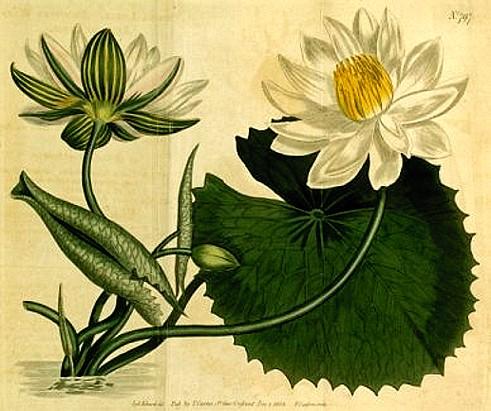
Loto deriva dal greco løtós (termine mediterraneo di origine oscura) tramite il latino lotus. Nome con cui sin dai tempi antichi si sono chiamate piante diverse. Il loto d'Egitto o loto bianco d'Egitto (Nymphaea lotus) della famiglia Nymphaeaceae, pianta sacra degli Egizi, è un'erba acquatica perenne con grandi fiori bianchi o rosei, diffusa nelle regioni calde e temperate dell'Eurasia, gran parte dell'Africa tropicale dove è presente con diverse varietà in tutte le raccolte d'acqua (laghi, stagni, fiumi, canali, ecc.). Crescita: pianta acquatica con un robusto rizoma radicato al fondo e foglie cuoriformi, sia sommerse che galleggianti; anche il fiore si sviluppa in superficie. Le sue foglie possono essere gigantesche (fino a mezzo metro di diametro) e il suo fiore bianco e profumato, di grande effetto, si apre soprattutto di notte. Posizione: in acquario è una tipica pianta protagonista per il centro della vasca, richiede adeguato spazio libero intorno a sé. Coltivazione: specie adatta solo a grandi acquari, meglio ancora se aperti e illuminati da lampade a vapori di mercurio; necessita infatti di molta luce e in tali condizioni fiorisce più facilmente. Preferisce acqua con un pH leggermente acido e una durezza medio-bassa.
Il loto
appare frequentemente nel simbolismo religioso di varie civiltà: nell'antico
Egitto il dio-sole, Horus![]() , è
raffigurato come un bambino seduto su un fiore di loto; in India, nella
letteratura puranica, Brahma nasce dal loto che esce dall'ombelico di Visnu;
Narayana, il mitico fanciullo divino primordiale che galleggia sulle acque e
dall'ombelico del quale spunta il loto, è simbolo dell'emergere primordiale
del cosmo. Attraverso l'iconografia del buddhismo Mahayana il loto è divenuto
inoltre elemento essenziale di tutte le raffigurazioni dell'arte buddistica
asiatica. Quale motivo decorativo ed elemento compositivo ricco di significati
esso apparve nell'arte delle primitive scuole buddistiche, diffondendosi poi
attraverso le raffigurazioni dell'arte iconica del Gandhara, regione storica
del Pakistan situata grosso modo nella piana di Peshawar. La sua forma si
prestò a essere sfruttata soprattutto nella scultura quale elemento portante
di statue (piedistallo o trono). Nel mondo islamico il motivo decorativo del
loto compare sulla ceramica e anche nella metallistica suggerendo talvolta la
forma stessa del recipiente, simile alla corolla del loto appena dischiusa.
, è
raffigurato come un bambino seduto su un fiore di loto; in India, nella
letteratura puranica, Brahma nasce dal loto che esce dall'ombelico di Visnu;
Narayana, il mitico fanciullo divino primordiale che galleggia sulle acque e
dall'ombelico del quale spunta il loto, è simbolo dell'emergere primordiale
del cosmo. Attraverso l'iconografia del buddhismo Mahayana il loto è divenuto
inoltre elemento essenziale di tutte le raffigurazioni dell'arte buddistica
asiatica. Quale motivo decorativo ed elemento compositivo ricco di significati
esso apparve nell'arte delle primitive scuole buddistiche, diffondendosi poi
attraverso le raffigurazioni dell'arte iconica del Gandhara, regione storica
del Pakistan situata grosso modo nella piana di Peshawar. La sua forma si
prestò a essere sfruttata soprattutto nella scultura quale elemento portante
di statue (piedistallo o trono). Nel mondo islamico il motivo decorativo del
loto compare sulla ceramica e anche nella metallistica suggerendo talvolta la
forma stessa del recipiente, simile alla corolla del loto appena dischiusa.
Alla
stessa famiglia appartiene il fior di loto, Nelumbo nucifera![]() . Loto
d'Egitto o loto falso viene chiamato l'albero di Sant'Andrea (Diospyros
lotus), della famiglia Ebenacee, specie arborea originaria dell'Asia,
coltivata in Europa come pianta ornamentale o quale portainnesto per il
congenere cachi. È denominato loto dei Lotofagi lo Zizyphus lotus
(giuggiolo selvatico
. Loto
d'Egitto o loto falso viene chiamato l'albero di Sant'Andrea (Diospyros
lotus), della famiglia Ebenacee, specie arborea originaria dell'Asia,
coltivata in Europa come pianta ornamentale o quale portainnesto per il
congenere cachi. È denominato loto dei Lotofagi lo Zizyphus lotus
(giuggiolo selvatico![]() ),
arbusto spinoso dell'Africa settentrionale e dell'Asia, dai frutti della
grossezza di una oliva, dolciastri, commestibili. Con il nome loto, infine, si
indicano genericamente le specie del genere Lotus, della famiglia
Papilionacee, e in particolare la ginestrina.
),
arbusto spinoso dell'Africa settentrionale e dell'Asia, dai frutti della
grossezza di una oliva, dolciastri, commestibili. Con il nome loto, infine, si
indicano genericamente le specie del genere Lotus, della famiglia
Papilionacee, e in particolare la ginestrina.
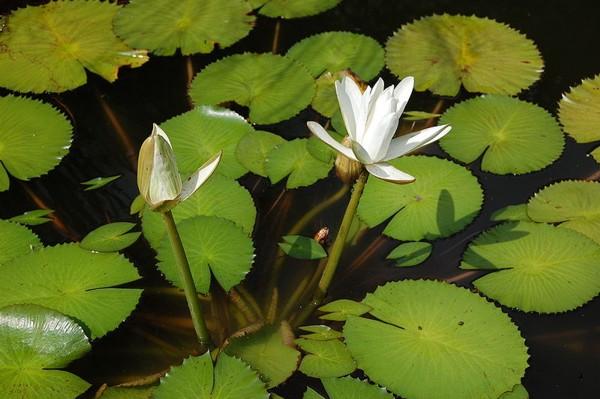
Nymphaea lotus, the Tiger Lotus, White lotus or Egyptian White Water-lily, is a flowering plant of the family Nymphaeaceae. It grows in various parts of East Africa and Southeast Asia. This species of water lily has lily pads which float on the water, and blossoms which rise above the water. It is a perennial, grows to 45 cm in height, and prefers clear, warm, still and slightly acidic waters. The color of the flower is white and sometimes tinged with pink. Nymphaea lotus is often used as an aquarium plant. Sometimes it is grown for its flowers, while other aquarists prefer to trim the lily pads, and just have the underwater foliage.
White lotus decorations - Frieze at a palace in Amarna (1352-1336 BC)
The ancient Egyptians cultivated the white lotus in ponds and marshes. This flower often appears in ancient Egyptian decorations. They believed that the lotus flower gave them strength and power; remains of the flower have been found in the burial tomb of Ramesses II. The number 1,000 in ancient Egyptian numerals is represented by the symbol of the white lotus. The ancient Egyptians also extracted perfume from this flower. They also used the white lotus in funerary garlands, temple offerings and female adornment. The white lotus might have been one of the plants eaten by the Lotophagi of Homer's Odyssey.
Fior
di loto
Nelumbo nucifera
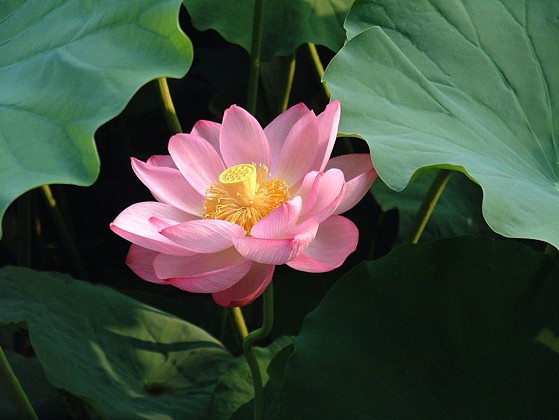
Il fior di loto asiatico (Nelumbo nucifera Gaertn., 1788) è una pianta acquatica originaria dell'Asia e dell'Australia, appartenente alla famiglia delle Nelumbonaceae. È una pianta a crescita rapidissima, tipica di stagni e invasi con acque stagnanti o quasi prive di corrente, profondi 5-50 cm ed oltre. Questa specie ha foglie di colore verde-glauco, peltate, di aspetto ceroso, grandi fino a 60 cm di diametro, che emergono per oltre 1 m dal pelo dell'acqua, con un lungo peduncolo che supera in lunghezza il picciolo. I fiori di grandi dimensioni, oltre 20 cm di diametro, sono colorati di rosa con un tipico profumo d’anice, con frutti molto ornamentali.
Il fior di loto viene considerato un fiore sacro per l'Induismo e il Buddhismo, mentre in India è uno dei simboli nazionali e appare nelle bandiere di alcuni principati indiani (prima dell'unificazione) e in due delle quattro varianti della bandiera dell'indipendenza indiana, presentata nel 1907 a Stoccarda da Bhikaiji Cama, una importante rappresentante del Movimento per l'indipendenza indiana.
Come pianta ornamentale è usata per decorare stagni, vasche e laghetti, o coltivata in vasche idroponiche I particolari frutti opportunamente essiccati vengono utilizzati nelle composizioni floreali, per decorare saloni e appartamenti Nel loto, i fiori, i semi, le foglie giovani e i rizomi sono tutti mangiabili. In Asia i petali vengono mangiati mentre le foglie sono solitamente utilizzate come piatto per il cibo. Il rizoma (pning in Cinese, ngau in Cantonese, bhe in India e Pakistan, e renkon in Giapponese) è utilizzato come condimento. I petali, le foglie e i rizomi possono essere consumati anche crudi, ma il rischio di trasmissione di parassiti consiglia una consumazione cotta.
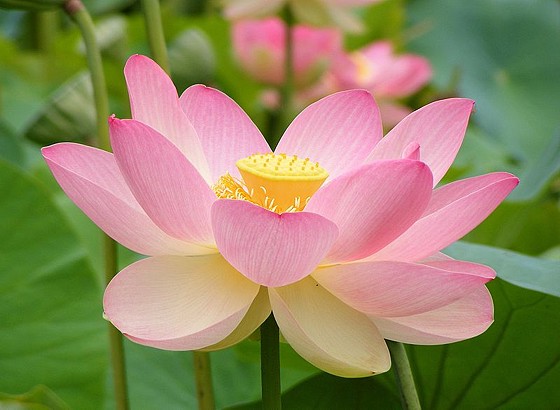
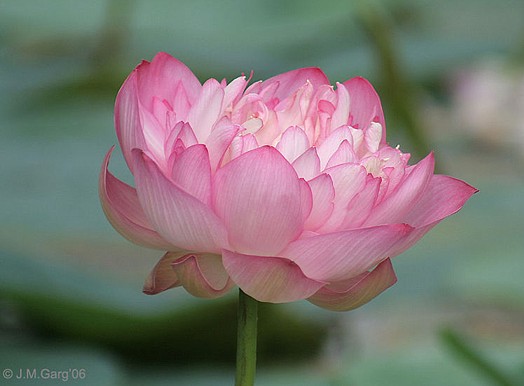
Nelumbo nucifera, known by a number of names including Indian lotus, sacred lotus, bean of India, or simply lotus, is a plant in the Nelumbonaceae family. Botanically, Nelumbo nucifera (Gaertn.) may also be referred to by its former names, Nelumbium speciosum (Wild.) or Nymphaea nelumbo. This plant is an aquatic perennial. Under favorable circumstances its seeds may remain viable for many years, with the oldest recorded lotus germination being from that of seeds 1300 years old recovered from a dry lakebed in northeastern China.
A common misconception is referring to the lotus as a water-lily (Nymphaea), an entirely different plant as can be seen from the centre of the flower, which clearly lacks the structure that goes on to form the distinctive circular seed pod in the Nelumbo nucifera. It should also be noted that water-lilies come in various colors, whereas the lotus has flowers only in hues of pink, or white. Native to Greater India and commonly cultivated in water gardens, the lotus is the national flower of India and Vietnam.
Plant
taxonomy systems agree that this flower is in the Nelumbo genus, but
disagree as to which family Nelumbo is in, or whether it should be part
of its own unique family and order tree. According to the U S Department of
Agriculture, water lilies make up the family Nymphaeaceae of the order Nymphaeales.
The roots of Nelumbo nucifera are planted in the soil of the pond or river
bottom, while the leaves float on top of the water surface. The flowers are
usually found on thick stems rising several centimeters above the water. The
plant normally grows up to a height of about 150 cm and a horizontal spread of
up to 3 meters, but some unverified reports place the height as high as over 5
meters. The leaves may be as large as 60 cm in diameter, while the showy
flowers can be up to 20 cm in diameter.
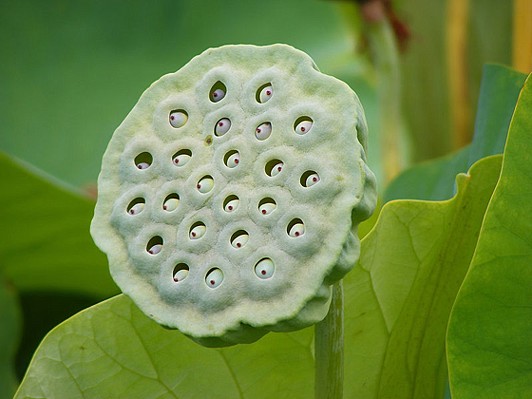
Researchers report that the lotus has the remarkable ability to regulate the temperature of its flowers to within a narrow range just as humans and other warmblooded animals do. Dr. Roger S. Seymour and Dr. Paul Schultze-Motel, physiologists at the University of Adelaide in Australia, found that lotus flowers blooming in the Adelaide Botanic Gardens maintained a temperature of 86 to 95 degrees Fahrenheit, even when the air temperature dropped to 50 degrees. They suspect the flowers may be turning up the heat for the benefit of their coldblooded insect pollinators. The study, published in the journal Nature, is the latest discovery in the esoteric field of heat-producing plants. The very few other species known so far to be able to regulate their temperature include Skunk Cabbage and a Philodendron known as Elephant Ear. The traditional Sacred Lotus is distantly related to Nymphaea caerulea, and possesses similar chemistry. Both Nymphaea caerulea and Nelumbo nucifera contain the alkaloids nuciferine and aporphine.
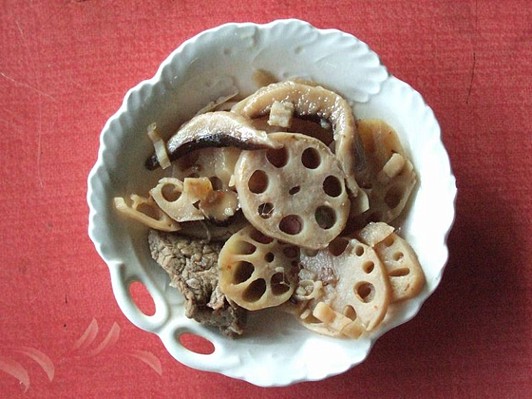
Boiled, sliced lotus roots used in various Asian cuisine
The distinctive dried seed heads, which resemble the spouts of watering cansphoto, are widely sold throughout the world for decorative purposes and for dried flower arranging. The flowers, seeds, young leaves, and "roots" (rhizomes) are all edible. In Asia, the petals are used sometimes for garnish, while the large leaves are used as a wrap for food. In Korea, the leaves and petals are used as a tisane. Yeonkkotcha is made with dried petals of white lotus and yeonipcha is made with the leaves. The rhizome is used as a vegetable in soups, deep-fried, stir-fried, and braised dishes. Petals, leaves, and rhizome can also all be eaten raw, but there is a risk of parasite transmission (e.g., Fasciolopsis buski): it is therefore recommended that they be cooked before eating.
Lotus rootlets are often pickled with rice vinegar, sugar, chili and/or garlic. It has a crunchy texture with sweet-tangy flavours. In Asian cuisine, it is popular with salad, prawns, seasame oil and/or coriander leaves. Lotus roots have been found to be rich in dietary fiber, vitamin C, potassium, thiamin, riboflavin, vitamin B6, phosphorus, copper, and manganese, while very low in saturated fat.
The stamens can be dried and made into a fragrant herbal tea called liánhuā cha in Chinese, or (particularly in Vietnam) used to impart a scent to tea leaves. The lotus seeds or nuts are quite versatile, and can be eaten raw or dried and popped like popcorn, phool makhana. They can also be boiled until soft and made into a paste, or boiled with dried longans and rock sugar to make a tong sui (sweet soup). Combined with sugar, lotus seed paste becomes one of the most common ingredients used in pastries such as mooncakes, daifuku, and rice flour pudding. Various parts of the lotus are also used in traditional Asian herbal medicine.

Hindu goddess Lakshmi holding & standing on a lotus
Hindus revere it with the divinities Vishnu and Lakshmi often portrayed on a pink lotus in iconography. In the representation of Vishnu as Padmanabha (Lotus navel), a lotus issues from his navel with Brahma on it. Goddess Sarasvati is portrayed on a white-colored lotus. Often used as an example of divine beauty, Vishnu is often described as the 'Lotus-Eyed One'. Its unfolding petals suggest the expansion of the soul. The growth of its pure beauty from the mud of its origin holds a benign spiritual promise. In Hindu iconography, other deities, like Ganga and Ganesha are often depicted with lotus flowers as their seats.
The lotus plant is cited extensively within Puranic and Vedic literature, for example:
One who performs his duty without attachment, surrendering the results unto the Supreme Lord, is unaffected by sinful action, as the lotus is untouched by water. — Bhagavad Gita 5.10:
This has also taken root in Chinese cultures with a famous statement made by the Confucian scholar Zhou Dunyi: I love the lotus because while growing from mud, it is unstained.
In Buddhist iconography, Buddha is often represented on a pink lotus. In Buddhist symbolism, the lotus represents purity of the body, speech, and mind as if floating above the muddy waters of attachment and desire. It is also to be noted that most Buddhist, Chinese, Hindu, Japanese, amongst other Asian deities are often are depicted as seated on a lotus flower. According to legend, Gautama Buddha was born with the ability to walk and everywhere he stepped, lotus flowers bloomed.
In the classical written and oral literature of many Asian cultures the lotus is present in figurative form, representing elegance, beauty, perfection, purity and grace, being often used in poems and songs as an allegory for ideal feminine attributes. In Sanskrit the word lotus (padma) has many synonyms, like ambuja, niraj, pankaj, pankaja, kamal, kamala, kunala, aravind, arvind, nalini and saroja and names derived from the lotus, like padmavati (possessing lotuses) or padmini (full of lotuses). These names and derived versions are often used to name girls, and to a lesser extent boys, in India, Nepal and Sri Lanka, as well as in many other countries influenced by Indic culture, like Thailand, Cambodia, Indonesia and Laos.
The Padma Shri, a civilian award given by the Government of India, has the words "Padma" and "Shri" in Devanagari appear above and below a lotus flower on its obverse. BJP, a nationalist political party of India which claims to be at the forefront of India's cultural nationalism, uses the lotus as its election symbol. Japanese rock musician Miyavi uses the lotus and a crescent moon with the kanji of his name (meaning 'elegance') above, as his insignia.